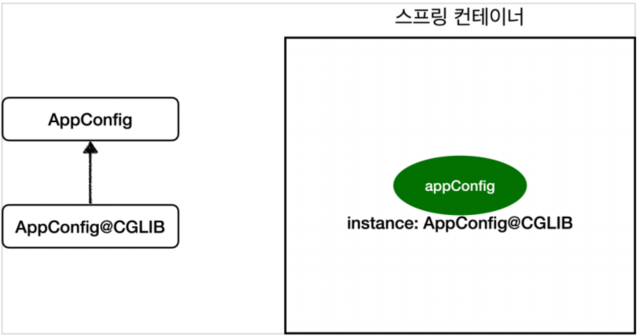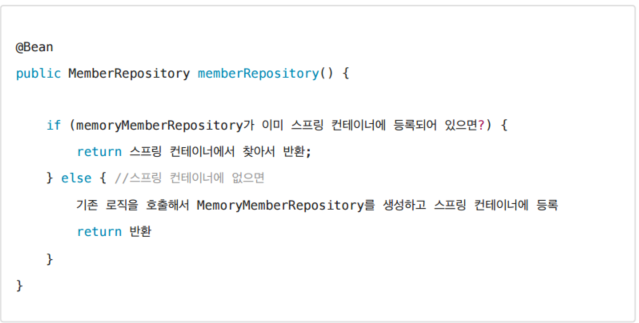주 내용은 자바위주로 정리가 되어있습니다.
싱글톤 패턴
클래스의 인스턴스가 딱 1개만 생성하는 디자인 패턴.
사용하는 이유
- 메모리 낭비 방지
public class Test {
void Test() {
AppConfig appConfig = new AppConfig();
MemberService memberService1 = appConfig.memberService();
MemberService memberService2 = appConfig.memberService();
}
}위 코드처럼 서비스 요청이 있을 때마다 객체가 생성된다고 하자.
요청 100개가 있으면 객체를 100번 생성해야하는 메모리의 낭비가 발생하는데 이를 방지함.
- 다른 클래스간에 데이터 공유가 쉽다.
싱글톤 인스턴스가 전역으로 사용되는 인스턴스이기 때문에 다른 클래스의 인스턴스들이 접근하여 사용할 수 있다.
구현 방법
여러 방법이 있으나 가장 대표적인 holder 방법으로 구현한다.
- static 영역에 객체 instance를 미리 하나 생성해서 올려둔다.
- 이 객체 인스턴스가 필요하면 오직 getInstance() 메서드를 통해서만 조회할 수 있다. 이 메서드를 호출하면 항상 같은 인스턴스를 반환한다.
- 딱 1개의 객체 인스턴스만 존재해야 하므로, 생성자를 private으로 막아서 혹시라도 외부에서 new 키워드로 객체 인스턴스가 생성되는 것을 막는다.
- holder안에 선언된 instance가 static이기 때문에 클래스 로딩시점에 한번만 호출될 것이며 final을 사용해 다시 값이 할당되지 않도록 만든 방법.
public class ExampleClass {
// 외부에서 생성자에 접근하지 못하게.
private ExampleClass() {}
//
private static class InnerClass() {
private static final ExampleClass instance = new ExampleClass();
}
public static ExampleClass getInstance() {
return InnerClass.instance;
}
}
문제점
- 싱글톤 패턴을 구현하는 코드 자체가 많이 들어간다.
- 의존관계상 클라이언트가 구체 클래스에 의존한다. DIP를 위반한다.
- 클라이언트가 구체 클래스에 의존해서 OCP 원칙을 위반할 가능성이 높다.
- 테스트하기 어렵다.
- 내부 속성을 변경하거나 초기화 하기 어렵다.
- private 생성자로 자식 클래스를 만들기 어렵다.
- 결론적으로 유연성이 떨어진다.
스프링에서는 이러한 싱글톤의 단점들을 해결하면서 장점을 취할 수 있는 스프링 컨테이너를 제공한다.
주의점
싱글톤 패턴이든, 스프링과 같은 싱글톤 컨테이너를 사용하든, 하나의 인스턴스를 공유하기 때문에 상태를 유지(stateful)하지 않고 무상태(stateless)로 설계해야 한다.
- 특정 클라이언트에 의존적인 필드가 있으면 안된다.
- 특정 클라이언트가 값을 변경할 수 있는 필드가 있으면 안된다.
- 가급적 읽기만 가능
- 필드 대신에 자바에서 공유되지 않는, 지역변수, 파라미터, ThreadLocal 등을 사용해야 한다.
문제 코드(공유필드가 있을 경우)
public class StatefulService {
private int price; // 상태를 유지하는 필드
public void order(String name, int price){
System.out.println("name = " + name + " price = " + price);
this.price = price; // 여기가 문제!
}
public int getPrice(){
return price;
}
}
class StatefulServiceTest {
@Test
void statefulServiceSingleton(){
AnnotationConfigApplicationContext ac = new AnnotationConfigApplicationContext(TestConfig.class);
StatefulService statefulService1 = ac.getBean(StatefulService.class);
StatefulService statefulService2 = ac.getBean(StatefulService.class);
//ThreadA: A사용자 10000원 주문
statefulService1.order("userA", 10000);
//ThreadB: B사용자 20000원 주문
statefulService2.order("userB", 20000);
int price = statefulService1.getPrice();
System.out.println("priceA = " + price);
}
static class TestConfig {
@Bean
public StatefulService statefulService(){
return new StatefulService();
}
}
}
priceA = 20000이 출력되는 에러가 발생.개선 코드
public class StatefulService {
// private int price; // 상태를 유지하는 필드
public int order(String name, int price){
System.out.println("name = " + name + " price = " + price);
return price;
}
}
class StatefulServiceTest {
@Test
void statefulServiceSingleton(){
AnnotationConfigApplicationContext ac = new AnnotationConfigApplicationContext(TestConfig.class);
StatefulService statefulService1 = ac.getBean(StatefulService.class);
StatefulService statefulService2 = ac.getBean(StatefulService.class);
int userAPrice = statefulService1.order("userA", 10000);
int userBPrice = statefulService1.order("userB", 20000);
Assertions.assertThat(userAPrice).isEqualTo(10000);
Assertions.assertThat(userBPrice).isEqualTo(20000);
}
static class TestConfig {
@Bean
public StatefulService statefulService(){
return new StatefulService();
}
}
}스프링 컨테이너
스프링 패턴을 적용하지 않아도, 인스턴스를 싱글톤으로 관리해준다.
@Configuration
public class AppConfig {
@Bean
public MemoryMemberRepository memberRepository() {
System.out.println("call AppConfig.memberRepository");
return new MemoryMemberRepository();
}
// new DiscountPolicy가 중복되지 않게
@Bean
public DiscountPolicy discountPolicy(){
return new RateDiscountPolicy();
}
@Bean
public MemberService memberService(){
System.out.println("call AppConfig.memberService");
return new MemberServiceImpl(memberRepository());
}
@Bean
public OrderService orderService(){
System.out.println("call AppConfig.orderService");
return new OrderServiceImpl(memberRepository(), discountPolicy());
}
}AppConfig.class라는 빈 관련 설정파일에서 sout를 통해 알아보자. 위 코드 상으로는 memberRepository()가 3번 호출되므로 System.out.println("call AppConfig.memberRepository");도 3번 실행되지만 결과는?
call AppConfig.memberRepository
23:08:07.772 [main] DEBUG org.springframework.beans.factory.support.DefaultListableBeanFactory - Creating shared instance of singleton bean 'discountPolicy'
23:08:07.776 [main] DEBUG org.springframework.beans.factory.support.DefaultListableBeanFactory - Creating shared instance of singleton bean 'memberService'
call AppConfig.memberService
23:08:07.779 [main] DEBUG org.springframework.beans.factory.support.DefaultListableBeanFactory - Creating shared instance of singleton bean 'orderService'
call AppConfig.orderService
이렇게 1번만 호출되는 것을 확인할 수가 있는데 이것이 가능한 이유는 CGLIB라는 바이트코드 조작 라이브러리 덕분이다.
CGLIB, @Configuration
스프링 컨테이너는 싱글톤 레지스트리다. 따라서 스프링 빈이 싱글톤이 되도록 보장해주어야 한다. 그런데 스프링이 자바 코드까지 어떻게 하기는 어렵다. 위 자바 코드를 보면 분명 3번 호출되어야 하는 것이 맞다. 그래서 스프링은 클래스의 바이트코드를 조작하는 CGLIB라는 라이브러리를 사용한다.
@Test
void configurationDeep(){
AnnotationConfigApplicationContext ac = new AnnotationConfigApplicationContext(AppConfig.class);
AppConfig bean = ac.getBean(AppConfig.class);
System.out.println(bean.getClass());
}위 코드를 실행하면 class com.example.basic.AppConfig335108b9라고 뜬다.
순수한 클래스라면 class hello.core.AppConfig라고 떠야하는데 클래스 명에 xxxCGLIB가 붙으면서 상당히 복잡해진 것을 볼 수 있다. 이것은 내가 만든 클래스가 아니라 스프링이 CGLIB를 이용해서 AppConfig 클래스를 상속받은 임의의 다른 클래스를 만들고, 그 다른 클래스를 스프링 빈으로 등록한 것이다.

AppConfig@CGLIB 예상 코드

중요한것은 @Configuration 어노테이션을 사용해야만 CGLIB가 작동해서 싱글톤을 보장한다는것! @Bean만 사용해도 스프링빈으로 등록은 된다 하지만, 싱글톤을 보장하지 않고 생성되는 인스턴스도 모두 다르다.
출처 : 김영한의 스프링 핵심 원리 -기본편
